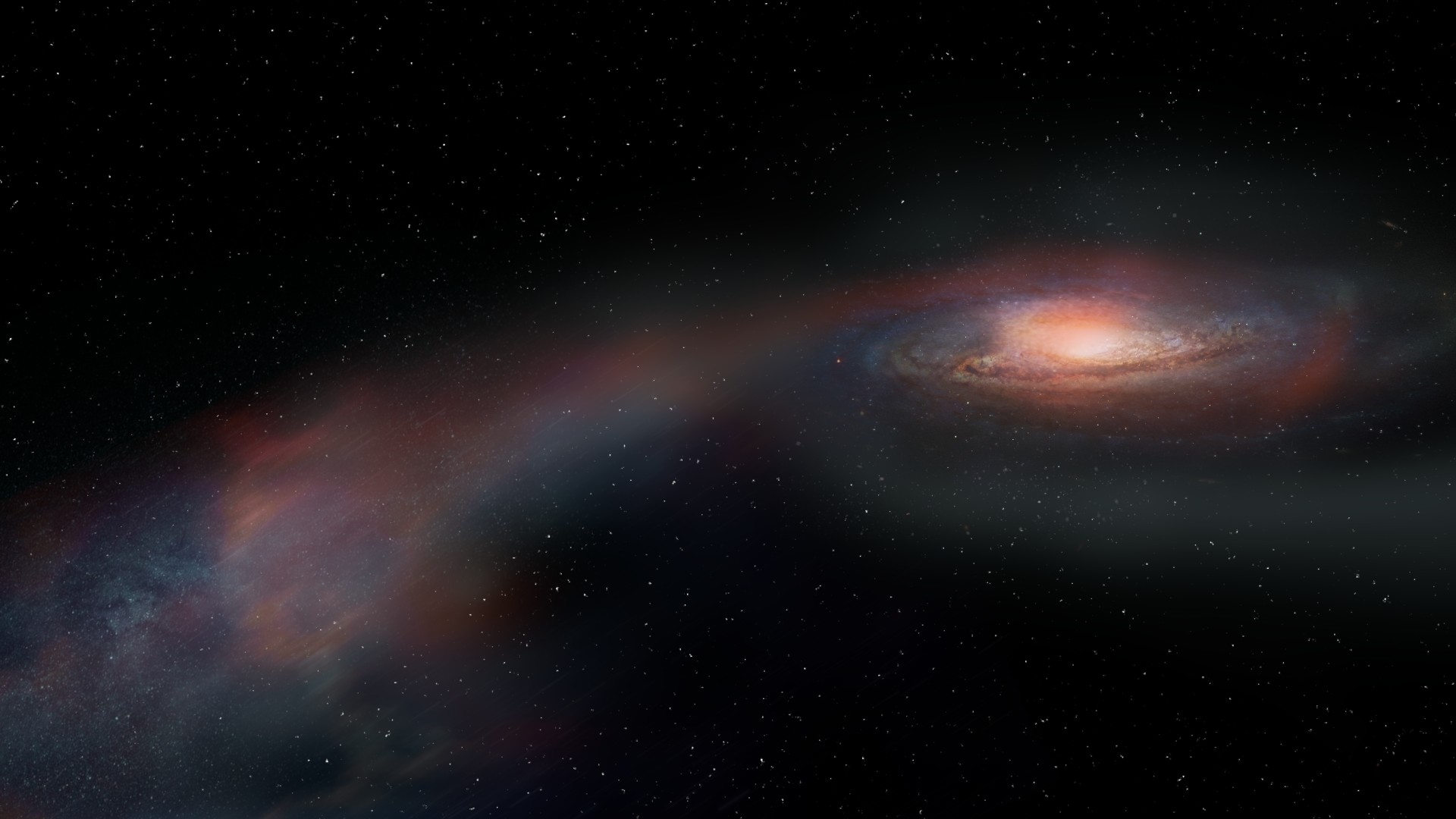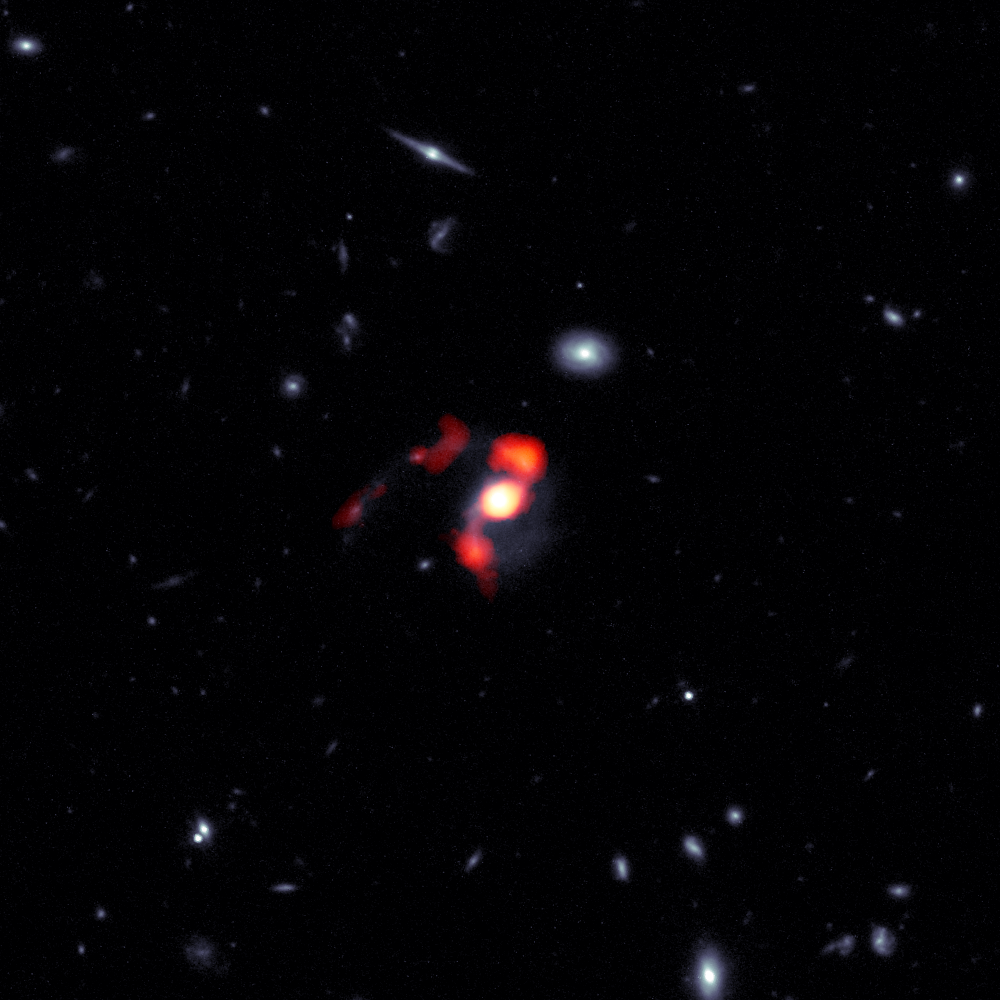Cosmic 'tug-of-war' between galaxies created a tidal tail of whipped-away stars
The galaxy SDSS J1448+1010 and its tail of ejected stars and gas was formed when the universe was around half its current age.

A distant galaxy stopped birthing stars when a merger with another galaxy ripped out its star-forming gas and stars, a violent process that left it with a massive 'tail' of star-stuff.
SDSS J1448+1010 was formed when the universe was roughly half its current age of 13.8 billion years old from the collision of two progenitor galaxies. This resulted in a cosmic tug of war arising from each galaxy's gravitational influence. This tussle ripped stars and gas from the resultant galaxy leaving it with a massive stream of material emerging from it which astronomers call a 'tidal tail.'
For SDSS J1448+1010 this tail contains around half of the galaxy's cold star-forming gas — equivalent to 10 billion times the mass of the sun. This indicates that the merger may be responsible for halting star formation in the now dormant galaxy.
Related: Supermassive black hole pair nearest Earth is locked in a violent cosmic dance
The unexpected results could change the way astrophysicists think about the cessation of star-formation, often referred to as the 'death' of galaxies, showing that slower processes like galactic mergers can play a role as well as more rapid events.
The merger, which has now almost finished, was observed by astronomers using the Atacama Large Millimeter/submillimeter Array (ALMA) in Northern Chile, and the Hubble Space Telescope.
"What initially made this massive galaxy interesting was that, for some reason, it suddenly stopped forming stars about 70 million years ago immediately following a burst of star-forming activity," Texas A&M University astronomer Justin Spilker said in a statement. "Most galaxies are happy to just keep forming stars."
Get the Space.com Newsletter
Breaking space news, the latest updates on rocket launches, skywatching events and more!
Spilker, the lead author of a paper detailing the discovery, went on to explain that the team's observations with the ALMA and Hubble seemed to show the reason SDSS J1448+1010 stopped forming stars is the merger that ejected half of its star-forming gas to interstellar space.
"With no fuel, the galaxy couldn't keep forming stars," he added.

Discovering the role that interactions, collisions, and mergers play in the evolution of galaxies could help researchers better comprehend how galaxies 'live and die.'
"When we look out at the Universe, we see some galaxies that are actively forming new stars, like our own Milky Way, and some that aren't," research co-author and University of California Santa Cruz cosmologist, Wren Suess, explained. "But those 'dead' galaxies have many old stars in them, so they must have formed all of those stars at some point and then stopped making new ones.
"This discovery shows just how powerful these major galaxy mergers are, and how much they can affect how a galaxy grows and changes over time," Suess continued.
The next step for this research could be to discover just how common galactic 'tugs of war' like the one that gave SDSS J1448+1010 its massive tail are and if this is commonly linked with dormant galaxies that have slowed star-formation.
That would mean finding more examples of galaxies like SDSS J1448+1010, or studying galaxies like J1448+1010 that astronomers have already been lucky enough to catch mid-collision.
"Astronomers used to think that the only way to make galaxies stop forming stars was through really violent, fast processes, like a bunch of supernovae exploding in the galaxy to blow most of the gas out of the galaxy and heat up the rest," Spilker concluded. "Our new observations show that it doesn't take a 'flashy' process to cut off star formation. The much slower merging process can also put an end to star formation and galaxies."
The team's results were presented in a paper published in the Aug. 29 edition of the Astrophysical Journal Letters.
Follow us on Twitter @Spacedotcom or on Facebook.
Join our Space Forums to keep talking space on the latest missions, night sky and more! And if you have a news tip, correction or comment, let us know at: community@space.com.

Robert Lea is a science journalist in the U.K. whose articles have been published in Physics World, New Scientist, Astronomy Magazine, All About Space, Newsweek and ZME Science. He also writes about science communication for Elsevier and the European Journal of Physics. Rob holds a bachelor of science degree in physics and astronomy from the U.K.’s Open University. Follow him on Twitter @sciencef1rst.









